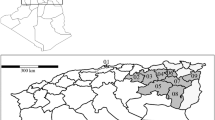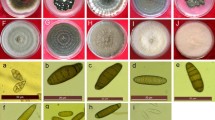Abstract
SeveralAlternaria cassiae isolates were recovered from diseased sicklepod plants (Senna obtusifolia) in the southern regions of Brazil. A representative isolate (Cenargen CG593) was tested for its host range under greenhouse conditions. The fungus promoted symptoms in sicklepod, cassava (Manihot dulce), tomato (Lycopersicon esculentum) and eggplant (Solanum melongena) when tested at a spore concentration of 106 spores ml−1. When the plants were inoculated with a suspension of 105 spores ml−1 and held at a dew period of 12 h (cassava) or 18 h (tomato and eggplant), the plants showed symptoms of the disease, but they recovered and continued their normal vegetative growth. These results show that the fungusA. cassiae is safe to use for the control ofS. obtusifolia under Brazilian conditions, because it did not cause excessive damage in the three plants tested.
Similar content being viewed by others
References
Andersen, R.N. and Walker, H.L. (1985)Colletotrichum coccodes: A pathogen of Eastern Black Nightshade (Solanum ptycanthum).Weed Sci. 33:902–905.
Charudattan, R., Walker, H.L., Boyette, W.H., Ridings, W.H., TeBeest, D.O., Van Dyke, C.G.et al. (1986) Evaluation ofAlternaria cassiae as a mycoherbicide for sicklepod (Cassia obtusifolia) in regional field tests.Southern Coop. Ser. Bull. 317, Ala. Agric. Exp. Stn. Auburn Univ., AL, USA.
Figueiredo, G. de, Fontes, E.G., Teixeira, C.A.D. and Pais, J.S. (1992) Levantamento e seleçäo de patógenos para o controle biológico de fedegoso (Senna obtusifolia: Leguminosae). [Surveying and selection of pathogens for biological control of sicklepod (Senna obtusifolia: Leguminosae)].Fitopatol. Brans. 17:169 (in Portuguese).
Kissmann, K.G. and Groth, D. (1999) Plantas Infestantes e Nocivas. [Invasive and Noxious Plants.] 2nd ed. BASF, São Paulo, Brasil (in Portuguese).
Levin, M.A. and Strauss, H. (1993) Overview of risk assessment.in: Levin, M.A. and Strauss, H. [Eds] Risk Assessment in Genetic Engineering. McGraw-Hill, New York, NY. pp. 1–17.
Masangkay, R.O., Mabbayad, M.O., Paulitz, T.C. and Watson, A.K. (1999) Host range ofAlternaria alternata f.sp.sphenocleae causing leaf blight ofSphenoclea zeylanica.Can. J. Bot. 77:103–112.
Mello, S.C.M., Avila, Z., Ribeiro, Z.M. de A., Fontes, E.G. and Esteles, R.S. (1996) Efeito da idade da planta, concentraçäo de inóculo e periodo de orvalho no controle deSenna obtusifolia porAlternaria cassiae. [Influence of plant age, inoculum concentration and dew period on control ofSenna obtusifolia byAlternaria cassiae.]Fitopatol. Bras. 21:371 (in Portuguese).
Mortensen, K. and Makowski, R.M.D. (1997) Effects ofColletotrichum gloeosporioides f.sp.malvae on plant development and biomass of non-target field crops under controlled and field conditions.Weed Res. 37:351–360.
Pitelli, R.A. (1992) Weed-soybean interference studies in Brazil.in: Cooping, L.G., Green, M.B. and Rees, R.T. [Eds.] Pest Management in Soybean. Elsevier, London, UK. pp. 282–290.
Shrum, R.D. (1982) Creating epiphytotics.in: Charudattan, R. and Walker, H.L. [Ed.] Biological Control of Weeds with Plant Pathogens. John Wiley & Sons, New York, NY, pp. 113–136.
Walker, H.L. (1982) A seedling blight of sicklepod caused byAlternaria cassiae.Plant Dis. 66:426–428.
Walker, H.L. and Tilley, A.M. (1997) Evaluation of an isolate ofMyrothecium verrucaria from sicklepod (Senna obtusifolia) as a potential mycoherbicide agent.Biol. Control 10:104–112.
Wapshere, A.J. (1974) A strategy for evaluating the safety of organisms for biological weed control.Ann. Appl. Biol. 77:201–211.
Weidemann, G.J. (1991) Host-range testing: safety and science.in: TeBeest, D.O. [Ed.] Microbial Control of Weeds. Chapman & Hall, New York, NY. pp. 83–96.
Yang, S.-M., Johnson, D.R. and Dowler, W.M. (1990) Pathogenicity ofAlternaria angustiovoidea on leaf spurge.Plant Dis. 74:601–604.
Author information
Authors and Affiliations
Corresponding author
Additional information
http://www.phytoparasitica.org posting Jan. 14, 2007.
Rights and permissions
About this article
Cite this article
Pitelli, R.L.C.M., Penariol, M., Pitelli, A.M.C.M. et al. Host specificity of a brazilian isolate ofAlternaria cassiae (Cenargen CG593) under greenhouse conditions. Phytoparasitica 35, 123–128 (2007). https://doi.org/10.1007/BF02981105
Received:
Accepted:
Issue Date:
DOI: https://doi.org/10.1007/BF02981105




